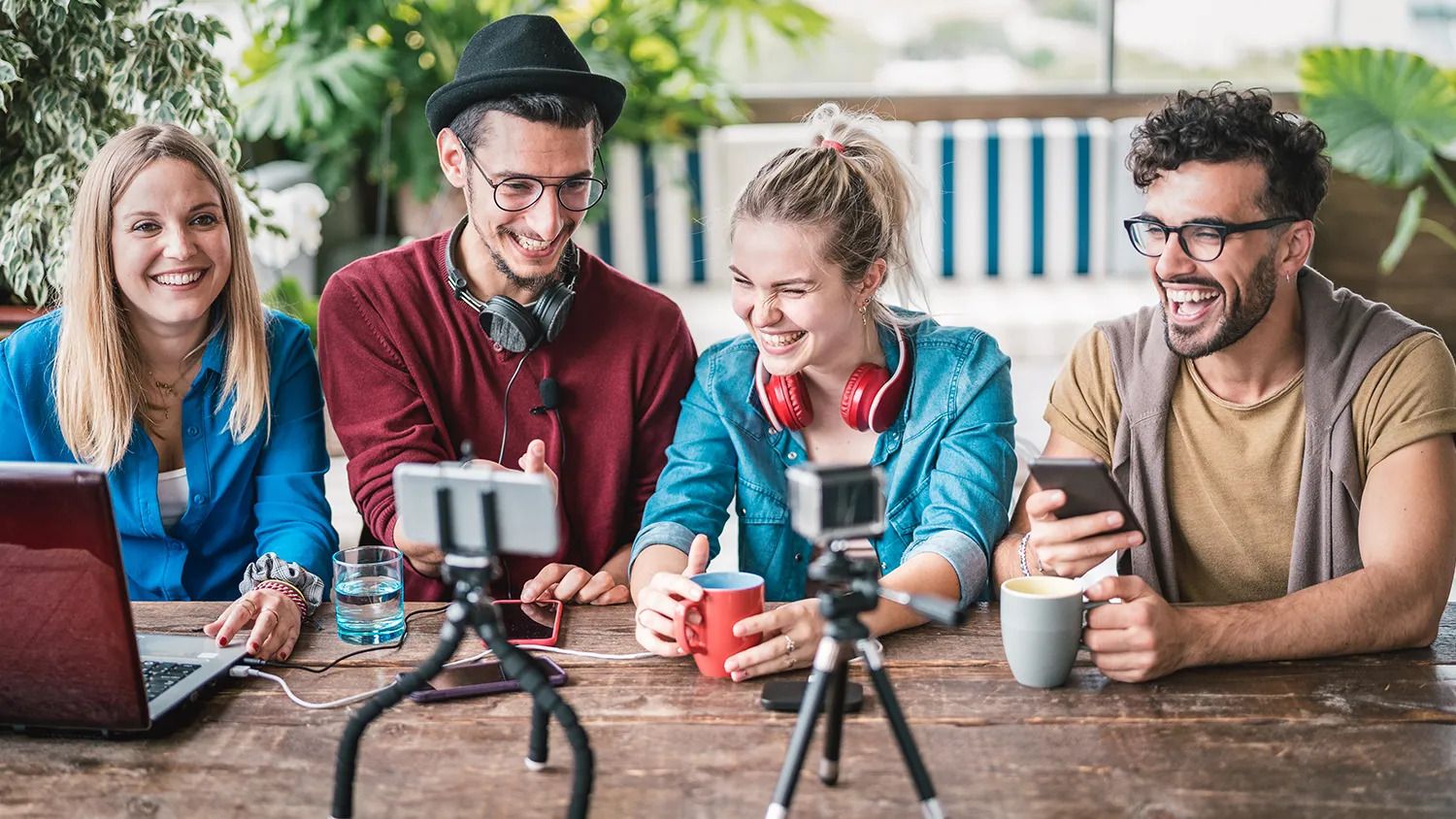As the new year approaches, it’s time to look ahead, identify the trends that will shape the landscape, and figure out how to incorporate them into your business strategy.
Through team discussions, client feedback, and analyzing the results of thousands of campaigns this past year, we’ve pinpointed the influencer marketing trends that will dominate in 2025.
Let’s explore the trends you need to know!
Trend 1: AI's Continued Rise
AI and the Rise of Virtual Influencers
Let’s start with a major trend. Since the debut of ChatGPT, AI-powered applications have surged in popularity, offering innovative solutions to nearly every challenge marketers face. From content creation to data analysis, AI is handling the routine tasks, freeing up marketers to focus on more strategic efforts. And influencer marketing is no exception to this AI revolution.

One notable development is the growth of virtual influencers. These digital personalities are expanding not only as entirely AI-generated figures but also as virtual versions of popular real-life influencers. For instance, Meta is currently testing features that enable influencers to create digital avatars of themselves that can interact with followers, answer questions, and more. While it's still early to gauge the practical success of these tools, they hold the potential to ease the workload of influencers in engaging with their audiences.
Virtual influencers have been around for some time, but expect to see an increasing number of them appearing in your social media feeds, as creating them becomes simpler than ever before.
AI's Role in Enhancing Influencer Marketing
AI is also enhancing how marketers collaborate with real influencers. From fine-tuning campaign strategies to creating briefs, and even analyzing results, AI will play a crucial role in streamlining the entire process.
AI is particularly valuable in influencer discovery. Searching manually for the right influencers can be a long, tedious process. With AI, however, you can provide specific criteria, and it will instantly suggest the perfect influencers for your campaign. SocialBook offers this Al Requirement Diagnosis feature and you can give it a try with only a few clicks. It provides smart influencer suggestions and optimal collaboration strategies by evaluating your target region, budget, and preferred platforms.

There’s so much more to explore about AI’s impact on influencer marketing, but we’ll save that for another time. The important message here is to embrace AI as a tool to improve your workflow, not something to fear. Think of it as a powerful ally to help your team work smarter, not harder.
Trend 2: The Return of Brand Marketing
The Shift from Performance to Brand Marketing
The age-old debate: performance marketing versus brand marketing. In today’s data-driven era, many companies have shifted their focus toward performance marketing because it’s easier to measure. While marketers around the world recognize the importance of building a strong brand for long-term growth, the pressure to deliver immediate results often leads to neglecting brand-focused strategies.

A cautionary tale comes from Nike’s recent struggles. After betting heavily on a direct-to-consumer (DTC) model, Nike experienced a significant setback. Their shift in strategy led to a 20% drop in stock value, showing that neglecting brand marketing in favor of performance marketing can backfire. Nike is still grappling with the consequences.
While performance marketing will continue to play a vital role in the marketing mix, it's clear that brand marketing is making a necessary comeback. With consumers becoming more resistant to ads, using ad blockers, and seeking authenticity in an increasingly curated world, brand marketing will be critical for maintaining customer loyalty and attracting new audiences. Relying solely on performance marketing, especially in the face of ad fatigue, is risky—whether in investing, farming, or marketing. Even in the era of DTC growth, there is significant value in ensuring your products are available both online and on store shelves.
And it's not just smaller companies that are learning this lesson. Even industry giants like Adidas have been adjusting their strategies. In 2019, Adidas heavily invested in performance marketing, believing it was the key to driving revenue. However, studies revealed that brand activity was actually responsible for 65% of sales across retail, wholesale, and e-commerce, while performance marketing also contributed to those areas. This shift in understanding highlights the importance of balancing both approaches.
Influencer Marketing’s Role in Brand Building
Influencer marketing plays a crucial role here, particularly in ensuring the right brand alignment to resonate with audiences. As we move forward, influencer marketing will become an essential part of brand marketing strategies, and its role will only grow in significance.

Ida Nevala, Marketing Communications Manager at Fonum, offers valuable insight into the importance of brand marketing:
"In recent years, data-driven digital marketing has pushed many brands to focus on what directly impacts sales. This shift has led to a decline in long-term brand awareness and customer loyalty—something that larger companies are starting to recognize. At Fonum, we prioritize building long-term brand awareness, investing in it strategically rather than through short-term campaigns. While short campaigns can drive immediate sales, their impact is fleeting and doesn’t create lasting connections with customers."
Looking for the right influencer to boost your brand? SocialBook helps you connect with influencers based on engagement, audience demographics, and brand fit, making it easy to find the perfect match for your marketing needs.



This trend signals a shift back toward brand-building strategies, making it clear that long-term investments in brand loyalty will be just as important as short-term performance-driven results.
Trend 3: Mastering Social Commerce for Brand Success
The Rise of Social Commerce and Live Shopping
Social platforms are continuously enhancing their social commerce capabilities to help influencers drive direct sales rather than just promoting products. It’s now easier than ever to make in-app purchases or watch live-streamed unboxings with clickable links leading directly to the featured products.

Live-streaming has seen a surge in popularity, with 27% of internet users watching live content weekly. On social media, 37% of users find live video the most engaging type of content, and 43% of users aged 18-34 prefer Instagram for live video. This trend is expected to grow, making now the perfect time to develop a live-streaming strategy.
The Future of Social Commerce Across Platforms
A few years ago, live shopping seemed to be the next big thing, but platforms like TikTok paused their live shopping plans for Europe, and Meta discontinued its live shopping features in 2023. However, social commerce is still thriving on platforms like YouTube and Twitch, and TikTok is set to relaunch its shopping features in Europe—prompting Meta to likely follow suit after analyzing TikTok's successes and failures.

The key advantage of social commerce and live shopping? Instead of influencers simply sharing a product link with a discount code, they can now showcase the products live, and viewers can make direct purchases within the app, with discounts and commissions already included.
Trend 4: Growing Emphasis on Measurable Results
Brand Marketing and the Need for Metrics
Here’s the paradox: we’ve just discussed how brand marketing—often difficult to measure—will be a key focus, but at the same time, there’s increasing pressure to track and prove results. How do these two ideas align?
Let us clarify. Over time, marketers have become more skilled at demonstrating the impact of their efforts, and brand marketing reporting has made strides in that direction. While it's not always possible to measure every outcome, there are valuable metrics available, such as follower growth, share of voice, and more.
Tools for Measuring Campaign Performance
As a result, tools and services are evolving to help marketers track these metrics more effectively.
For instance, with SocialBook, we've enhanced our influencer search capabilities, which helps you identify the best influencers for achieving measurable outcomes. You can assess influencers based on factors like:
- Audience demographics
- Content views
- Follower count
- Engagement rates


This allows you to choose influencers who not only fit your brand values but also deliver measurable results.
As social platforms continue to refine their analytics, they’ll offer even more insights into who is viewing your content and the actions they take.
So, don’t shy away from measuring your campaigns—there are plenty of tools available to track performance effectively.
Trend 5: Building Long-Term Influencer Relationships for Lasting Impact
The Power of Long-Term Influencer Partnerships
While short-term influencer campaigns can deliver results, the real value lies in forming long-term partnerships with influencers who truly resonate with your brand values.
These collaborations can extend beyond just social media posts—think about live product unboxings, detailed reviews, or even inviting influencers to moderate your events. For example, having an influencer you trust promote your event could lead to more sign-ups than a traditional paid ad campaign ever could.
How SocialBook Supports Long-Term Collaborations
A sustained partnership between your brand and an influencer builds a natural, long-term connection. Over time, when consumers see the influencer or your brand, they’ll immediately associate the two, establishing trust and fostering loyalty.
Some brands even go so far as to let influencers take over their social media channels. This gives the influencer the opportunity to engage with followers in an authentic, human way, while also helping consumers connect on a deeper level with the brand.

When considering influencers for long-term collaborations, take the time to explore their content and engage with their community. How do they interact with their audience? What values do they promote, and do they come across as genuine? These insights are crucial in deciding whether they’re a good fit for a lasting partnership.
SocialBook makes it easy to find and connect with the right influencers for long-term success. With its powerful Discovery Tool, you can access real-time metrics pulled directly from Instagram and TikTok, ensuring you’re working with authentic data. Once you’ve found the right influencers, you can add them to your list of preferred creators for future collaborations.
Trend 6: Simplified and Enhanced Cross-Platform Campaigns
Easier Cross-Platform Campaigns
Cross-platform influencer marketing will become more seamless and effective in the coming years. Social media giants like YouTube, Pinterest, Snapchat, and Instagram are continuously evolving, introducing new tools for creators and expanding their reach. These innovations will make it easier for brands to execute campaigns across multiple platforms while repurposing content effortlessly.
New Tools for Greater Engagement
For instance, influencers will be able to create branded filters that users can apply on different platforms, amplifying brand engagement beyond just one channel. They could also host live streams that broadcast simultaneously across several platforms, maximizing exposure with minimal effort.

While these features may be expensive and complex to implement today, we expect them to become more accessible and user-friendly in the near future. As these tools improve, marketers will be able to craft even more immersive and interactive experiences that resonate deeply with their audience.
Trend 7: Micro-Influencers Will Deliver Greater Impact
Micro-Influencers Are Key to Stronger Results
Mega influencers are still relevant, but micro and niche influencers are becoming increasingly valuable for brands.
Instagram’s recent shift to using "Views" as the primary content metric has mixed reactions. While it allows brands to measure reach more accurately, it also highlights a growing issue: influencers with large followings may not have their content seen by many of their followers due to algorithm changes. This shift shows that follower count isn’t as important as it once was.

Higher Engagement with Smaller Influencers
Micro and niche influencers often have better engagement rates than mega influencers. Their smaller, more dedicated audiences foster stronger connections and a sense of authenticity. These influencers are typically seen as more real and relatable, which attracts followers who connect with their genuine persona.
If your campaign's goals align, micro-influencers could deliver stronger, more meaningful results without the need for a large budget.
Final Thought
As influencer marketing evolves, staying ahead means embracing trends like AI, brand marketing, social commerce, and micro-influencers. By using tools like SocialBook, brands can find the right influencers, track results, and build lasting partnerships. Stay ahead of the curve and make the most of these opportunities for success.







